
Delayed cord clamping is believed to lower the risk of anaemia in the child after delivery.
Delayed cord clamping reaps benefits for newborn babies, particularly those who are premature or at risk of anaemia
Some parents have turned to delayed cord clamping, a practice where the umbilical cord is clamped and cut two to three minutes after delivery – instead of immediately. The belief, which is supported by some evidence, is that there are benefits for the child, such as a lower risk of anaemia if clamping is delayed.
The practice also supposedly benefits babies born prematurely as they face the risk of intraventricular bleeding or bleeding in the brain, which in turn can lead to brain damage. The practice is uncommon in Singapore, although many obstetricians will perform it at the patient’s request in uncomplicated cases, said Dr Tan Eng Loy, Consultant, Department of Obstetrics and Gynaecology, Singapore General Hospital (SGH), a member of the SingHealth group.
Cord clamping was originally introduced to reduce the risk of the mother experiencing serious bleeding after giving birth, a potentially fatal condition. For convenience, the cord was usually clamped within a minute of delivery.
But, said Dr Tan, “Immediate cord clamping has not been universally accepted as part of the active management of the third stage of labour (when the placenta is expelled after the delivery of the baby). ”Surveys in Europe showed a large variation in practice with only 15 per cent of healthcare units in Austria and 17 per cent in Denmark practising immediate cord clamping, versus as many as 77 per cent of units in the United Kingdom," he said.
Babies carried to full term but who are at risk of anaemia or whose mothers are iron-deficient, can benefit from delayed cord clamping, said Dr Tan. At birth, an extra volume of blood resides in the placenta. Delayed clamping lowers the risk of anaemia and increases the number of red blood cells in newborns.
Before the cord is clamped, blood continues to pulse from the placenta back to the baby until the pulses naturally stop several minutes after birth. For an infant delivered at full term, this is equivalent to receiving an additional 80ml to 100ml of blood, or an extra 20 to 30 mg/kg of iron, sufficient for the baby for about three months.
For preterm infants, the practice is also associated with a smaller risk of necrotising enterocolitis, a serious condition that involves tissue death in the bowels, and intraventricular haemorrhage, Dr Tan said.
Delayed cord clamping increases jaundice risk and needs further research
One downside of delayed clamping, said Dr Tan, is the stronger risk of the baby developing jaundice. A common condition in newborns, jaundice occurs when bilirubin builds up in the blood. Bilirubin, produced by the normal breakdown of red blood cells, normally passes through the liver and is excreted as bile through the intestines. Phototherapy uses light to eliminate the excess bilirubin.
So, it is imperative that a mother undergoing an uncomplicated full-term delivery understand the jaundice risk.
In preterm infants too, Dr Tan would only recommend it in uncomplicated deliveries not requiring immediate resuscitation.
Another drawback is that no clear standards of practice for delayed cord clamping has been defined, such as the best time to clamp, said Associate Professor Yeo Cheo Lian, Senior Consultant, Department of Neonatal and Developmental Medicine, Singapore General Hospital (SGH).
She added that while some studies report a reduction in immediate post-delivery intraventricular haemorrhage in premature babies (less than 33 weeks), there has been no significant difference in the overall outcome of these infants. The effects of this practice on mothers also have not yet been adequately studied, she said.
Still, if there are no other complications, delayed clamping should pose very little risk to the mother, said Dr Tan. But it should not be done in cases such as severe maternal bleeding, if the umbilical cord is wound tightly around the baby’s neck, or if the baby is asphyxiated and requires immediate resuscitation.
Ref: S13
Contributed by















 Get it on Google Play
Get it on Google Play